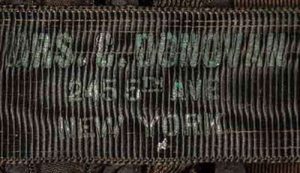Catherine Donovan was born in Ireland in 1826. She emigrated to the United States when she was a child. She later studied fashion design in Paris and established a dressmaking business in New York. Donovan sold imported gowns by Worth and Pingat and her own designs were heavily influenced by French designers. Donovan became favored by New York’s upper-class ‘400’ elites. As stated in her biography from the Philadelphia Museum of Art, “Her employees’ baggage was seized at U.S. customs on suspicion of smuggling. It was common practice for seized goods to be auctioned publicly, and in 1893 over five hundred people attended an auction of Worth, Pingat, and other gowns seized from Donovan.” Her obituary stated that “The Goelets, Astors, and Vanderbilts were patrons of Mrs. Donovan. The wedding gown worn by the Duchess of Marlborough (Consuelo Vanderbilt) was made under her supervision.” By 1900, her premises were located on Madison Avenue in a brownstone building where she also lived.
Donovan died in 1906, leaving no children. A number of examples of her work are exhibited at the Met.
Written by Sine McEllin of Ian Drummond Vintage
